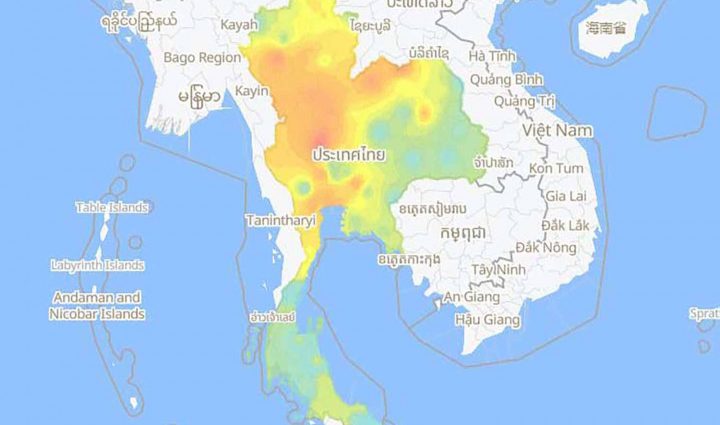PUBLISHED : 27 Dec 2023 at 10:40

Forty-two out of 77 provinces in Thailand were blanketed with thick and harmful levels of ultrafine dust on Wednesday morning and the affected regions were mostly in the Central Plains, the lower North and the upper Northeast, according to the Geo-Informatics and Space Technology Development Agency (Gistda).
The space research agency reported at 9am that levels of particulate matters 2.5 micrometres and less in diameter (PM2.5) recorded over the past 24 hours ranged from 38.0 to 69.5 microgrammes per cubic metre (µg/m³).
These values were classified in the orange category, meaning the levels of PM2.5 had started to affect health. The safe threshold is 37.5µg/m³, according to the government. The World Health Organisation (WHO) guidelines recommend 25 µg/m³ as the acceptable threshold for the daily average.
Gistda reported that no provinces were reported to have reached the red-coded, or seriously hazardous, levels.
The worst level of 69.5µg/m³ was measured in the central province of Samut Sakhon. Other provinces experiencing orange levels of PM2.5 were as follows:
Samut Songkhram (64.4)
Chai Nat (64.2)
Nakhon Pathom (63.5)
Nakhon Sawan (62.5)
Phichit (61.7)
Ratchaburi (60.9)
Uthai Thani (60.7)
Phitsanulok (59.2)
Samut Prakan (58.7)
Nakhon Phanom (57.1)
Loei (56.8)
Suphan Buri (56.1)
Nonthaburi (55.8)
Bangkok (55.2)
Sukhothai (55.0)
Kamphaeng Phet (54.6)
Tak (54.5)
Kanchanaburi (53.3)
Pathum Thani (52.3)
Phetchaburi (52.2)
Lamphun (51.9)
Phetchabun (51.0)
Nakhon Nayok (50.9)
Uttaradit (49.7)
Nong Bua Lam Phu (49.2)
Udon Thani (48.9)
Kalasin (47.4)
Nong Khai (45.7)
Prachin Buri (44.5)
Prachuap Khiri Khan (43.6)
Ayutthaya (43.4)
Lampang (43.1)
Sakon Nakhon (43.1)
Chachoengsao (42.6)
Chiang Mai (40.5)
Phrae (40.3)
Lop Buri (39.9)
Ang Thong (39.3)
Nan (38.8)
Maha Sarakham (38.5)
Khon Kaen (38.0)

